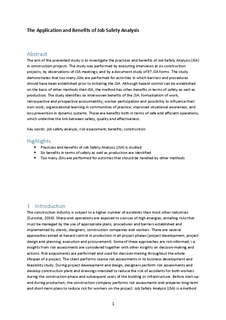| dc.contributor.author | Albrechtsen, Eirik | |
| dc.contributor.author | Solberg, Ingvild | |
| dc.contributor.author | Svensli, Eva | |
| dc.date.accessioned | 2019-04-01T07:32:11Z | |
| dc.date.available | 2019-04-01T07:32:11Z | |
| dc.date.created | 2018-12-30T09:36:03Z | |
| dc.date.issued | 2018 | |
| dc.identifier.citation | Safety Science. 2018, 113 425-437. | nb_NO |
| dc.identifier.issn | 0925-7535 | |
| dc.identifier.uri | http://hdl.handle.net/11250/2592595 | |
| dc.description.abstract | The aim of the presented study is to investigate the practices and benefits of Job Safety Analysis (JSA) in construction projects. The study was performed by executing interviews at six construction projects; by observations of JSA meetings; and by a document study of 97 JSA forms. The study demonstrates that too many JSAs are performed for activities in which barriers and procedures should have been established prior to initiating the JSA. Although hazard control can be established on the basis of other methods than JSA, the method has other benefits in terms of safety as well as production. The study identifies six interwoven benefits of the JSA: formalisation of work; retrospective and prospective accountability; worker participation and possibility to influence their own work; organisational learning in communities of practice; improved situational awareness; and loss prevention in dynamic systems. These are benefits both in terms of safe and efficient operations, which underline the link between safety, quality and effectiveness. | nb_NO |
| dc.language.iso | eng | nb_NO |
| dc.publisher | Elsevier | nb_NO |
| dc.rights | Attribution-NonCommercial-NoDerivatives 4.0 Internasjonal | * |
| dc.rights.uri | http://creativecommons.org/licenses/by-nc-nd/4.0/deed.no | * |
| dc.title | The application and benefits of job safety analysis | nb_NO |
| dc.type | Journal article | nb_NO |
| dc.type | Peer reviewed | nb_NO |
| dc.description.version | acceptedVersion | nb_NO |
| dc.source.pagenumber | 425-437 | nb_NO |
| dc.source.volume | 113 | nb_NO |
| dc.source.journal | Safety Science | nb_NO |
| dc.identifier.doi | https://doi.org/10.1016/j.ssci.2018.12.007 | |
| dc.identifier.cristin | 1647825 | |
| dc.description.localcode | © 2018. This is the authors’ accepted and refereed manuscript to the article. Locked until 26.12.2021 due to copyright restrictions. This manuscript version is made available under the CC-BY-NC-ND 4.0 license http://creativecommons.org/licenses/by-nc-nd/4.0/ | nb_NO |
| cristin.unitcode | 194,60,25,0 | |
| cristin.unitname | Institutt for industriell økonomi og teknologiledelse | |
| cristin.ispublished | true | |
| cristin.fulltext | postprint | |
| cristin.qualitycode | 1 | |

